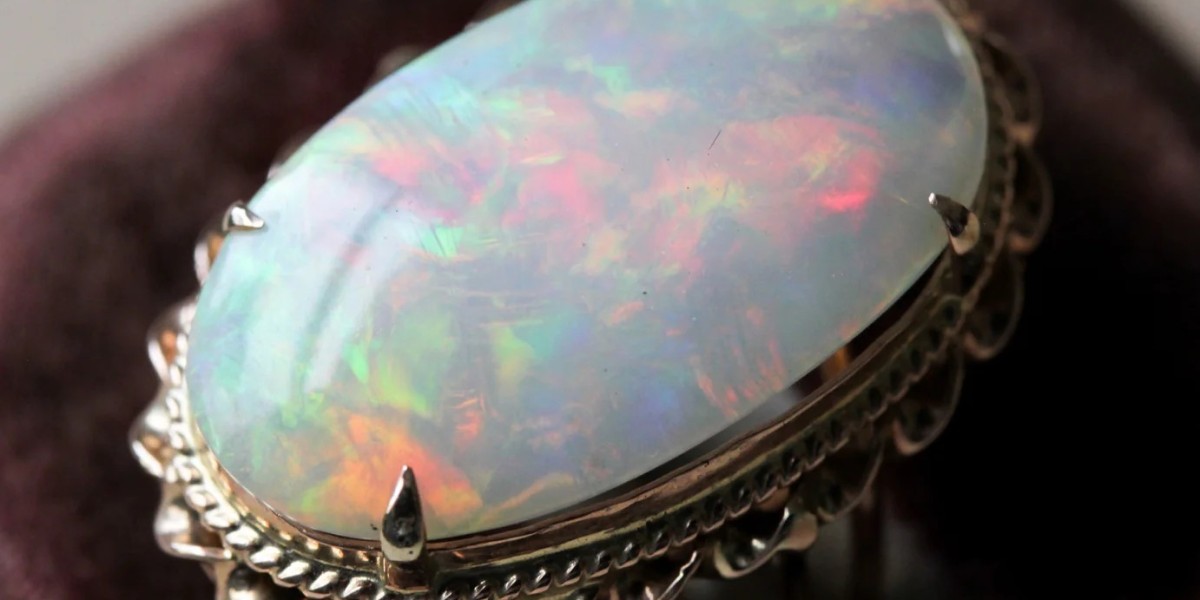Opal, some of the world’s most unusual and special gemstones, are noted for their iridescent, fire-like look. From a historical perspective, opals can be seen as a cluster of different stones. For a very long time, people thought that opals were composed of multiple gemstones. This was due to the fact that many opals contained vibrant patterns and color combinations. These people believed that red spots were rubies, green spots were emeralds, and so on. Opals have a long history of folklore and holistic use, which we can attribute to their iridescence and color play.
Although opals are some of the most artistically attractive stones that many people want, they are also the softest gem-grade stones in the jewelry industry. This is why opals require special care and protection, and it is difficult to maintain their bright fire and luster over time. In this post, we will go over all of the details about opals, including their history and symbolism. So, let us dig right into this article about the history of opals!
What is opal?
Opals come in many different shapes, colors, and sizes. Opal is not a mineral, but rather a mineraloid. It is primarily composed of hydrated (wet) amorphous silicon. Opal has a Mohs hardness range of 5.0 to 6.5. Opals are the traditional birthstone for the month of October, and according to the zodiac calendar, opals are ideal for all Librans.
When it comes to opals, they are classified into two varieties based on the color they take on during the formation process. The first category is precious opals, whereas the second is common opals. The precious opals have a magnificent optical phenomenon known as play-of-colors, which resembles a rainbow. On the other hand, ordinary opals do not exhibit play-of-colors, which is the primary distinction between the two varieties of opals.
So, what is the play of color in an opal?
Play-of-colors refers to an opal’s fire-like rainbow appearance, which diffracts light in different directions depending on the opal’s internal structure and the angle from which it is seen. A better approach to appreciate this concept is to think of it as an optical illusion: as white light (or any light) enters the stone, it interacts with the stone’s internal structure and exits with a flash of spectral hues.
Meaning of Opal.
Opal’s rich history and legend span centuries. Opals were thought to represent optimism and love in Ancient Rome, according to history. Because of their long history, opals have been associated with a variety of symbolisms and beliefs. Although opals are thought to bring good fortune, they can also bring bad luck to the wearer – it all depends on the setting.
Up until the middle of the 14th century, opals were thought to bring luck. However, opal’s reputation took a hit during the European Black Plague in the 14th century. There were rumors going about during this turbulent time that the owner of the opal jewelry would pass away if the hue of their opal got too bright.
This was how Opal’s fame declined in the mid-14th century. The same thing occurred in 1829.
In 1829, Sir Walter Scott published Anne of Geierstein, a fictional book in which one of the characters uses an opal amulet to gain mystical abilities. However, the book takes a terrible turn when holy water falls on the stone, killing the individual. Because Scott’s story was so famous and popular, people began to associate opals with death and bad luck. It was discovered that the very next year after this novel was published, opal sales had decreased by 50% across Europe, and these sales remained very low for the next 25 years or more.
History of Opals.
Many writers compared opals to explosions, volcanoes, and galaxies. Artists have given opals lovely poetic titles like Pandora, Empress, and Light of the World. The first opals discovered and used by humans date back to 4000 BC. These opals were discovered in Kenya in 1939 as old antiques in a cave.
In 75 AD, a Roman scholar, Pliny the Elder, wrote the following about opal: “Some opali carry such a play within them that they equal the deepest and richest colors of painters.” Others replicate the scorching flames of burning sulfur or the dazzling blaze of burning oil. He was fascinated by opals, exclaiming that this kaleidoscope stone had the green of emerald, the red of ruby, the blue of sapphire, the yellow of topaz, and the purple of amethyst.
In the Middle Ages, it was believed that opals might bring the user good fortune due to their rich color spectrum. Some people believed that wrapping a new bay leaf around an opal and holding it would make them invisible. This was one of the reasons why medieval robbers regarded Opal as a valuable jewel.
In certain civilizations, opals are thought to have supernatural origins and powers. For example, according to Arabic tales, opals descended from the heavens in the shape of lightning. The ancient Greeks believed that opals bestowed the ability of prophecy while also protecting them from various ailments.
Care & Maintenance of Opal Jewelry
Because opals are low on the Mohs Scale of mineral hardness, they should be handled with extreme caution. Another reason you should take excellent care of this stone is that it is quite liquid and quickly chips, cracks, and scratches. The easiest way to ensure that the opal stone placed in opal jewelry is safe is to have it put in a secure setting, such as a bezel.
If you want your opal jewelry to retain its vibrancy and play of hues, clean it on a regular basis. To clean your opal jewelry, use mild detergent and warm water. Clean your opal jewelry with a soft bristle toothbrush or lint-free towel. Then, immediately pat it dry with a clean, soft cloth. Bleaches and aggressive chemicals should never be used to clean opal jewelry since they might permanently harm it. Also, never immerse or submerge opal jewelry in water, as they absorb water, which can damage the stone.
Another thing you can do to improve the longevity of your opal jewelry is to take it to a jeweler for cleaning every six months or so. Only a jeweler can remove any residue or accumulation, such as filth and dust, from the jewelry setting.
Conclusion
So, we’ve come to the end of this post about the history of opal. Opals are stunning and unique stones that has been used throughout history as a symbol of truth, hope, and purity. Opals have been associated with negative connotations at times throughout history, however, they were simply human myths. Do you want to get your hands on opal rings, pendants, earrings, necklaces, or bracelets? We bet you’ll look stunning in them.
Are you seeking for wholesale opal jewelry or other kinds of wholesale gemstone jewelry? If so, pay a visit to 925 Silver Shine, India’s leading wholesale gemstone jewelry manufacturer and supplier, which has been exporting gemstone and sterling silver jewelry throughout the world since 2013. Their gemstone jewelry is available in over 250 different gemstones, and their designer jewelry collection is extensive, including birthstone, chakra, and zodiac sign jewelry. So, visit the 925 Silver Shine website and order the jewelry you need to take your retail business to new heights.








